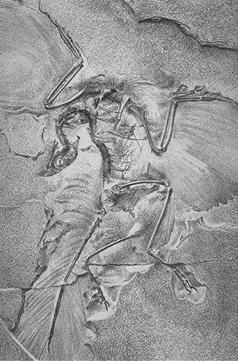16. The Berlin Archaeopteryx, 1881
 In
1877, a second and even more spectacular Archaeopteryx specimen was
discovered in the same Bavarian limestone that had yielded the first in
1861. It was more spectacular because the new specimen had a head. And
although the skull was somewhat birdlike, it was endowed with a full set
of reptilian teeth. Huxley's proposal that Archaeopteryx was a link
between birds and reptiles was greatly strengthened by the new discovery.
This specimen too was offered up for sale, but German authorities made
sure that it did not leave the country like its predecessor. It now rests
in the Humboldt Museum and is usually known as the Berlin specimen.
Several illustrations of the Berlin Archaeopteryx were published in
the years after its discovery, but we chose to exhibit this short article,
because of its author, and because of the nature and quality of the
reproduction. Harry G. Seeley was one of the great Victorian students of
dinosaurs, best known for his work on classifying dinosaurs (see
item 20). The illustration was produced from a photograph, with the
intermediary of an artist. It is small, only 13.5 x 11 cm., and thus quite
a contrast to Owen's enormous plate (see
item 14). But it is an exquisite lithograph, and it demonstrates that
an illustration need not be large to be effective.
In
1877, a second and even more spectacular Archaeopteryx specimen was
discovered in the same Bavarian limestone that had yielded the first in
1861. It was more spectacular because the new specimen had a head. And
although the skull was somewhat birdlike, it was endowed with a full set
of reptilian teeth. Huxley's proposal that Archaeopteryx was a link
between birds and reptiles was greatly strengthened by the new discovery.
This specimen too was offered up for sale, but German authorities made
sure that it did not leave the country like its predecessor. It now rests
in the Humboldt Museum and is usually known as the Berlin specimen.
Several illustrations of the Berlin Archaeopteryx were published in
the years after its discovery, but we chose to exhibit this short article,
because of its author, and because of the nature and quality of the
reproduction. Harry G. Seeley was one of the great Victorian students of
dinosaurs, best known for his work on classifying dinosaurs (see
item 20). The illustration was produced from a photograph, with the
intermediary of an artist. It is small, only 13.5 x 11 cm., and thus quite
a contrast to Owen's enormous plate (see
item 14). But it is an exquisite lithograph, and it demonstrates that
an illustration need not be large to be effective.
It is interesting to compare Seeley's illustration to that of Carl Vogt.
 Source:
Source:Seeley, Harry G.. "On some differences between the London and Berlin specimens referred to Archaeopteryx," in: Geological Magazine, series 2, vol. 8 (1881), pp. 454-455. This work is on display as exhibit item 16.


 ®Linda Hall Library
®Linda Hall Library5109 Cherry Street
Kansas City, MO 64110
Please direct comments to ashwortb@lhl.lib.mo.us